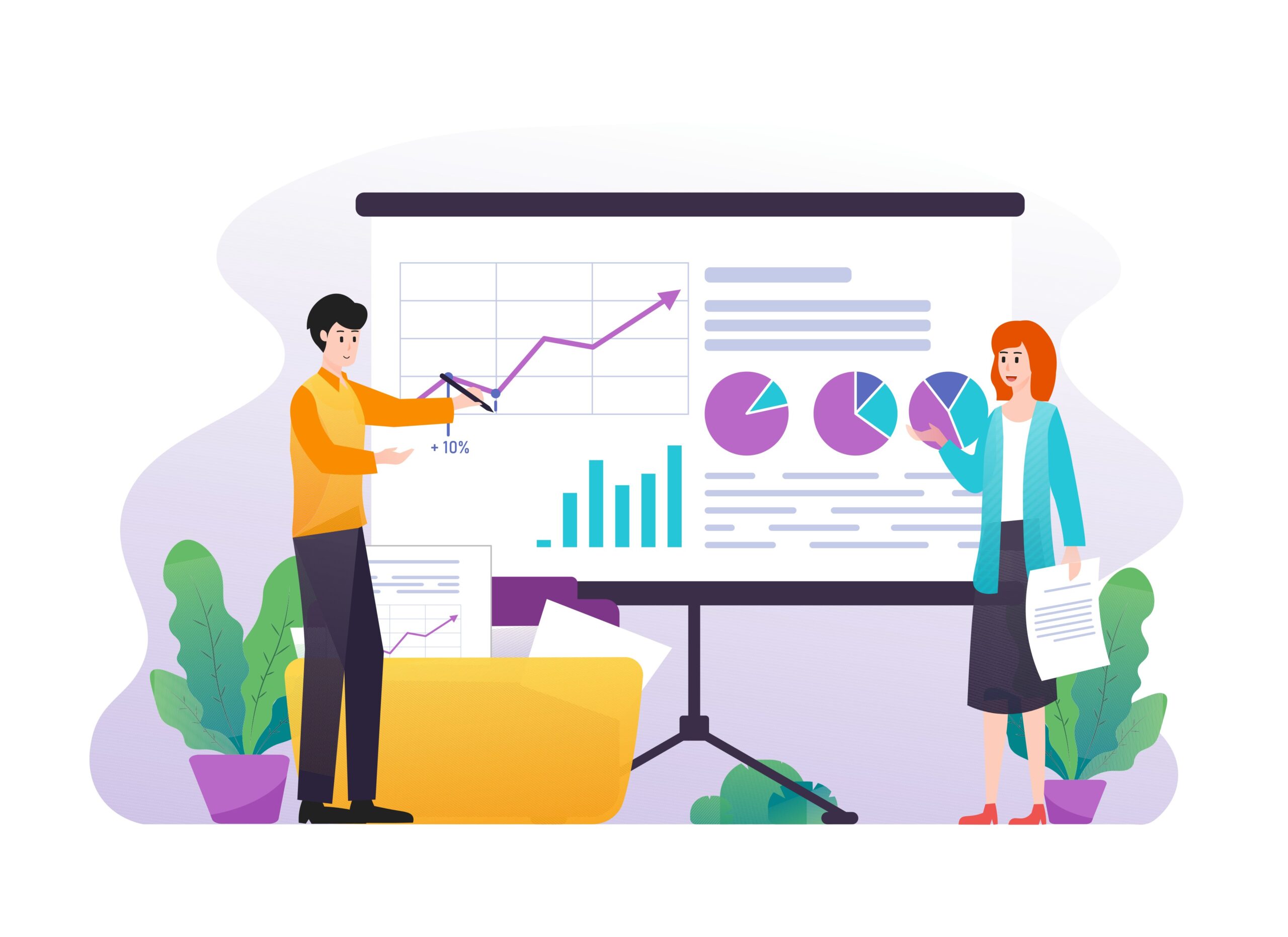Why Your eCommerce Store Needs a Real-Time Analytics Dashboard
Table of Contents
Running an eCommerce store today means juggling dozens of moving parts — from product launches and ad campaigns to inventory logistics and customer support. Every second, your store generates massive amounts of data: sales numbers, web traffic, clicks, conversions, and customer feedback. But data alone isn’t power — understanding it in the moment is.
That’s where a Real-Time Analytics Dashboard changes everything. Instead of waiting for end-of-day reports or relying on gut instinct, you get a live, unified view of what’s happening across your business right now. It connects your marketing, sales, and customer behavior into one intelligent system that updates the instant something changes.
Think of it as your digital command center — a place where insights replace guesswork. You can spot revenue trends as they form, see which products are surging in popularity, track ad performance in real time, and even identify when customers drop off before checkout. With a Real-Time Analytics Dashboard, you’re not reacting to yesterday’s data — you’re steering today’s decisions.
By turning fragmented information into clear, visual insights, it empowers you to act faster, refine your campaigns on the fly, and uncover opportunities for growth that would otherwise go unnoticed. In the next sections, we’ll explore how a Real-Time Analytics Dashboard works, why it’s indispensable for modern eCommerce, and how it can help you run a smarter, more agile business.
What Is a Real-Time Analytics Dashboard?
A Real-Time Analytics Dashboard is a live control center for your eCommerce store. It gathers, processes, and visualizes key metrics — like orders, traffic, and conversions — in real time. Instead of waiting for end-of-day or weekly reports, you get up-to-the-second updates that reveal what’s happening right now.
This dynamic approach combines your eCommerce analytics, marketing data, and sales metrics in one place, allowing you to make data-driven decisions instantly. The dashboard connects to platforms like Shopify, WooCommerce, Google Ads, and Meta Ads through APIs, ensuring continuous data flow.
At Engine Analytics, we design business intelligence tools that do exactly this — unifying data into visual dashboards that empower teams to act fast and stay informed.
Why Real-Time Analytics Is a Game-Changer
Every second in eCommerce counts. Prices fluctuate, ad campaigns shift, and customer preferences change overnight. Without real-time visibility, you’re always reacting — never anticipating.
Here’s why a Real-Time Analytics Dashboard transforms how you run your business.
1. Live Sales Performance Tracking
Static reports tell you what happened in the past. Real-time dashboards tell you what’s happening now. You can see your sales performance tracking data instantly — total orders, top products, revenue by region, and even how discounts affect profit margins.
Imagine launching a flash sale and watching conversions rise (or drop) live. You’ll know immediately whether to extend the offer, change pricing, or shift ad spending — without waiting for tomorrow’s numbers.
2. Understanding Customer Behavior as It Happens
Your customers leave valuable clues in their browsing and buying behavior. A Real-Time Analytics Dashboard helps decode these signals by showing what users are doing on your site right now.
Are they abandoning carts at checkout? Spending more time on mobile than desktop? Which campaigns drive the most engaged visitors?
With customer behavior insights, you can adjust your marketing and UX strategies instantly — improving the user journey while sales are still in motion.

The Power of Data-Driven Decision Making
Most businesses collect data, but few know how to use it in real time. With a Real-Time Analytics Dashboard, you turn your data into actionable intelligence.
- Optimize marketing spend: Adjust ad budgets mid-campaign when certain channels perform better.
- Manage stock proactively: Identify fast-selling items and reorder before they run out.
- Respond to issues instantly: Detect checkout errors or payment gateway failures before they affect hundreds of customers.
This kind of data-driven decision making gives you agility — a crucial edge in today’s competitive eCommerce space.
If you’re planning to strengthen your company’s analytics foundation for the coming year, you’ll love our guide on Preparing Your Business for 2026: A Data Analytics Checklist, which dives into setting up smarter analytics workflows.
Key Benefits of Using a Real-Time Analytics Dashboard
1. Unified Data in One Place
Most eCommerce teams waste hours switching between platforms. A Real-Time Analytics Dashboard consolidates your marketing, sales, and operational data into one screen. This reduces manual reporting and ensures everyone in your organization is working from the same numbers.
2. Faster Reaction Time
When trends shift, reacting late costs money. Real-time analytics eliminates that lag. For example, if traffic from paid ads drops suddenly, you can investigate and fix it immediately — before losing potential customers.
3. Improved Collaboration
Data silos kill performance. Real-time dashboards democratize access, allowing every department — marketing, finance, logistics, and management — to view live data simultaneously. This encourages shared accountability and cross-functional insights.
4. Enhanced Customer Experience
Customer experience is everything in eCommerce. Through business intelligence tools, you can identify pain points in real time, such as slow page loads or low mobile conversions, and fix them before they impact revenue.
5. Scalable Growth
As your store grows, so does the volume of data. A properly built Real-Time Analytics Dashboard scales effortlessly, handling millions of data points per day without delay — ensuring your insights stay accurate and timely.
How a Real-Time Analytics Dashboard Works
Behind every seamless visualization is a complex yet efficient process. A typical Real-Time Analytics Dashboard follows these steps:
- Data Integration: It connects to your data sources — CMS, CRMs, ad platforms, and payment systems — through secure APIs.
- Processing and Cleaning: The system standardizes formats, removes duplicates, and filters errors to maintain data quality.
- Visualization: Clean data is presented through graphs, gauges, and tables — customized for your KPIs.
- Automation and Alerts: The dashboard can send notifications about major events, like a sudden dip in sales or an inventory shortage.
At Engine Analytics, we integrate this process into tailored dashboards that bring clarity to complex datasets — so you focus on results, not raw numbers.
Must-Have Metrics for Your eCommerce Dashboard
A great Real-Time Analytics Dashboard doesn’t just show data — it highlights what matters most. Here are essential categories and KPIs every store should include:
Sales and Revenue
- Total revenue and profit margins
- Conversion rate by channel
- Average order value (AOV)
- Refund and return trends
Marketing and Traffic
- Top traffic sources (organic, paid, social, email)
- Click-through rates (CTR) for campaigns
- Cost per acquisition (CPA)
- Campaign ROI
Customer Insights
- Customer lifetime value (LTV)
- Repeat purchase rate
- Abandoned cart percentage
- Device and location analytics
Operations and Fulfillment
- Real-time inventory tracking
- Order processing time
- Shipment delays and costs
- Supplier performance metrics
Tracking these KPIs through eCommerce analytics ensures you’re not just collecting data — you’re acting on it.

Example: Reacting to Real-Time Data
Consider an online fashion retailer running a weekend promotion. Within hours, the Real-Time Analytics Dashboard shows traffic surging from Instagram ads but conversion rates dropping sharply.
This insight prompts the marketing team to check — they find the promo code isn’t working on mobile checkout. They fix the bug, issue a notification, and immediately see conversions recover.
Without real-time visibility, they would have lost an entire day of revenue. With it, they acted in minutes — demonstrating how live data drives tangible results.
Real-Time Dashboards and Predictive Analytics: The Next Step
While real-time data helps you understand the present, predictive analytics helps forecast the future. The best dashboards integrate both, enabling smarter planning.
For example, by analyzing historical buying patterns, you can anticipate product demand for upcoming holidays — adjusting marketing and stock in advance.
If you want to learn how to build dashboards that actually inspire action, explore our post on Building Dashboards That Drive Action: A Guide to Better Business Insights.
Bringing Teams Together with Business Intelligence Tools
A Real-Time Analytics Dashboard is not just for data analysts. Modern business intelligence tools are designed for everyone — marketers, sales leaders, and even logistics managers.
They break down complex datasets into visuals anyone can understand, removing the barrier between technical and non-technical users.
At Engine Analytics, we focus on creating BI dashboards that make collaboration effortless, helping eCommerce brands align around shared KPIs and growth goals.
Best Practices for Designing a Real-Time Analytics Dashboard
To get the most value from your dashboard, consider these best practices:
- Keep it simple: Focus on clarity. Don’t overload the screen with metrics; highlight what drives business impact.
- Prioritize usability: Ensure team members can filter, sort, and drill down into data easily.
- Automate where possible: Use scheduled alerts to notify you of performance shifts.
- Maintain consistency: Use standardized colors and labels for metrics across teams.
- Regularly update KPIs: As your business evolves, so should your dashboard focus areas.
These principles turn your dashboard from a reporting tool into a living, evolving system of insight.

How Real-Time Analytics Drives Better ROI
Every improvement driven by a Real-Time Analytics Dashboard — from faster marketing pivots to inventory optimization — compounds over time.
Here’s how ROI improves:
- Reduced wasted ad spend: Live performance tracking ensures you only invest in what’s working.
- Fewer stockouts and overorders: Real-time inventory data prevents lost sales and storage costs.
- Faster decision cycles: Teams act in minutes, not days, maximizing campaign and operational efficiency.
Real-time visibility translates into measurable profit gains — something every growing eCommerce store needs.
Choosing the Right Real-Time Analytics Partner
While off-the-shelf dashboards exist, they often fail to meet the unique needs of eCommerce operations. That’s why businesses partner with analytics experts like Engine Analytics to design tailored, scalable solutions.
Here’s what sets us apart:
- Custom integrations for Shopify, WooCommerce, and marketplaces
- Smart visualizations powered by intuitive BI technology
- Secure, cloud-based performance and uptime monitoring
- Hands-on support from analytics specialists
We don’t just deliver dashboards — we deliver clarity and control over your business performance.
Final Thoughts: Turning Data Into Real-Time Growth
In eCommerce, success isn’t about collecting data — it’s about using it at the exact moment it matters most. A Real-Time Analytics Dashboard empowers your business to move from reactive to proactive, giving you the speed and confidence to act the instant opportunities or challenges arise.
When your team can see live metrics for sales performance tracking, campaign ROI, and customer behavior insights, decision-making becomes sharper and execution becomes faster. Instead of spending hours digging through reports, you’ll have a single, dynamic dashboard that tells you what’s working — and what needs attention — right now.
The real advantage lies in agility. Imagine spotting a sudden traffic surge on a product page, adjusting your ad spend in real time, and instantly watching conversions climb. Or identifying a drop in checkout completion and fixing it before revenue takes a hit. That’s the kind of power real-time data gives your brand — the power to act, optimize, and grow continuously.
A Real-Time Analytics Dashboard doesn’t just simplify data management; it transforms your entire approach to running an online store. It unifies your marketing, sales, and operational insights so you can deliver smoother customer experiences, increase retention, and drive profitability without guesswork.
For an even deeper dive into how real-time insights impact eCommerce success, check out Shopify’s guide to eCommerce analytics and Google’s resources on eCommerce tracking in Google Analytics
Your business doesn’t have to wait for tomorrow’s report to make today’s decisions. Harness the clarity, speed, and precision that real-time data provides.
🚀 Contact Engine Analytics today to design your custom Real-Time Analytics Dashboard — and start transforming live insights into meaningful, measurable action.
Here’s Some Interesting FAQs for You
1. What makes a Real-Time Analytics Dashboard better than traditional reporting?
Traditional reports give you a backward look — showing what happened yesterday or last week. By the time you receive that data, opportunities to act may already be gone. A Real-Time Analytics Dashboard, on the other hand, updates automatically as data flows in, showing you what’s happening across your eCommerce store right now.
This instant visibility lets you spot trends as they form, not after the fact. You can respond to sudden drops in traffic, fix broken links, adjust ad spend mid-campaign, or identify product shortages — all in real time. It turns static numbers into living insights, allowing you to make faster, smarter decisions that directly impact growth.
2. Is it expensive to set up a Real-Time Analytics Dashboard?
Not at all. Many businesses assume advanced analytics require massive budgets or complex infrastructure, but that’s no longer true. Modern business intelligence tools and cloud-based integrations have made Real-Time Analytics Dashboards affordable and scalable for businesses of all sizes.
You can start small — tracking core metrics like sales, traffic, and conversions — and expand as your data needs grow. At Engine Analytics, we help clients customize dashboards that fit their goals and budget, ensuring you get maximum value without unnecessary complexity or cost.
3. How secure is real-time data tracking for eCommerce stores?
Data security is a top priority in real-time analytics. Trusted providers like Engine Analytics use encrypted data pipelines, secure APIs, and strict access controls to keep your business information safe at every stage. These protections ensure that sensitive metrics such as sales performance and customer details remain fully confidential.
Our systems are also built with compliance in mind — including GDPR and other data protection standards — to safeguard both your brand and your customers. With properly implemented Real-Time Analytics Dashboards, you gain visibility and insight without compromising security or trust.




